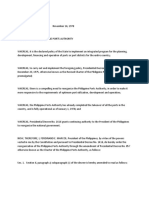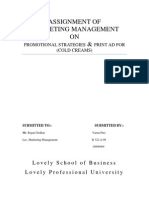Lecture 1
Uploaded by
Jose Leo Icaro TalionLecture 1
Uploaded by
Jose Leo Icaro TalionGEOTECHNICAL ENGINEERING 2(Foundation Engineering)
Lecturer: Engr. MMRTating
CHAPTER – 1 Lecture 1 COMPRESSIBILITY OF SOIL PROBLEM 1
A stress increase caused by the construction of Estimate the immediate settlement of a column footing 1.5
foundations or other loads compresses soil layers. The m in diameter that
compression is caused by several factors, such as (a) is constructed on an unsaturated clay layer if the total load
deformation of soil particles, (b) relocation of soil particles, carried by the
and (c) expulsion of water or air from void spaces. In general, column footing = 150 KN, E =7000 kN/m2 and ν = 0.25.
the soil settlement may be divided into three broad Assume the footing to be
categories. rigid.
1. Immediate settlement ( elastic settlement) – caused by FUNDAMENTALS OF CONSOLIDATION
the elastic deformation of dry, moist, and saturated soils, From concept of total and effective stress in soil;
without any change in moisture content . Δσ Δσ'u
2. Primary consolidation settlement – caused by a volume where : Δσ’ = increase in the effective stress
change in saturated cohesive soils due to expulsion of water Δu = increase in the pore water pressure
that occupies the void spaces.
3. Secondary consolidation settlement – caused by plastic
readjustment of soil fabrics after complete dissipation of
excess pore water pressure
Basic terms:
1. Compressibility – the property of soil by which volume
decrease occurs under applied pressure.
2. Consolidation – the process of gradual compression due
to the expulsion of pore water under steady state pressure
3. Compaction – the process of mechanical compression
resulting in reduction or compression of pore air and
consequent densification of soil.
CONTACT PRESSURE – SETTLEMENT PROFILE FOR CLAY
FLEXIBLE FOUNDATION RIGID FOUNDATION
CONTACT PRESSURE –SETTLEMENT PROFILE FOR SAND
FLEXIBLE FOUNDATION RIGID FOUNDATION
IMMEDIATE STTLEMENT “Se”:
1 υ2
Se ΔσB IP
E
where :
Se = immediate settlement
Δσ = net applied pressure
B = width of the foundation = diameter for circular
foundation
ν = soil poisson’s ratio
E = modulus of elasticity of soil
IP = nondimensional influence factor
1 m1 1
2
1
IP ) ln(m 1 m1 1)]
2
[m1ln( The gradual process of drainage under an additional load
π m1 application and the associated transfer of excess pore water
Where : pressure to effective stress causethe time-dependent
m1 = length of the foundation divided by its width settlement in the clay soil layer.
GEOTECHNICAL ENGINEERING 2(Foundation Engineering)
Lecturer: Engr. MMRTating
ONE DIMENSIONAL LABORATORY CONSOLIDATION TEST Gs = specific of gravity
The general shape of the Time-deformation plot of the ϒw = unit weight of water
specimen for a given load increment is shown in the figure. ρw = density of water
2. Calculate the initial height of the voids as Hv = H – Hs
3. Calculate the initial void ratio eo of the specimen using eo
= Vv/Vs = Hv A/HsA = Hv/Hs
4. Calculate the change in void ratio as Δe1 = ΔH1/Hs .
5. Calculate the new void ratio after consolidation as
e1 =eo - Δe1
TYPICAL PLOT OF VOID RATIO AGAINST EFFECTIVE SOIL
PRESSURE
STAGE 1 : INITIAL COMPRESSION – caused by preloading
STAGE 2 : PRIMARY CONSOLIDATION – during which excess
pore water pressure is gradually transferred into
effective stress due to expulsion of pore water. TYPICAL PLOT OF TYPICAL PLOT OF e
STAGE 3 : SECONDARY CONSOLIDATION – which occur after against e against log of σ’ log of σ’ Loading and
complete dissipation of the excess pore water pressure, Loading only reloading
when some deformation of the specimen takes place CASAGRANDE PROCEDURE FOR DETERMINING
due to the readjustment of the soil fabric. PRECONSOLIDATION PRESSURE
BASIC DEFINITIONS OF CLAY BASED ON STRESS HISTORY
1. NORMALLY CONSOLIDATED – whose present effective
overburden pressure is the maximum pressure that the soil
has been subjected to in the past
2. OVERCONSOLIDATED – whose present effective
overburden pressure is less than the soil has experience in
the past.
Preconsolidation pressure - is the maximum past
effective overburden pressure.
VOID RATIO-PRESSURE PLOTS
1. By visual observation, establish point a, at which the e –
log σ’ plot has a minimum radius of curvature.
2. Draw a horizontal line ab.
3. Draw the line ac tangent at a.
4.Draw the line ad, which is the bisector of the angle bac.
5. Project the straight-line portion gh of the e – log σ’ plot
back to the intersection line ad atf. The abcissa of point f is
the preconsolidation pressure σ’c.
Step by step procedure to determine the change in void
OVERCONSOLIDATION RATIO, OCR
ratio of the specimen withpressure.
σ'c
1. Calculate the height of solids, Hs in the specimen using OCR
Hs=Ws/AGsϒw = Ms/AGsρw σ'
where : Ws = dry weight of specimen Where ; σ‘c = preconsolidation pressure
Ms = dry mass of the specimen σ‘ = present effective vertical pressure
A = area of the specimen
GEOTECHNICAL ENGINEERING 2(Foundation Engineering)
Lecturer: Engr. MMRTating
EFFECT OF DISTURBANCE ON VOID RATIO – PRESSURE 5. Join points j and k. Point k is on curve 2 and its ordinate is
RELATIONSHIP 0.40eo
NORMALLY CONSOLIDATED CLAY PROBLEM 2
( Low to medium plasticity) Following are the results of a laboratory consolidation test
on a soil specimen
obtained from the field. Dry mass of specimen = 128 g.,
height of specimen at
the beginning of the test = 2.54 cm, Gs = 2.75 and area of
the specimen = 30.68
cm2 . Make necessary calculations and draw the e vs log σ’
curve.
Effective Final height of
pressure σ’ specimen at the
(ton/ft2) end of consolidation
(cm)
0 2.540
0.5 2.488
1. In the figure, curve 2 is the laboratory e – log σ’ plot. 1 2.465
From this plot, determine the preconsolidation pressure. 2 2.431
Draw vertical line ab. 4 2.389
2. Calculate the void ratio in the field eo. 8 2.324
16 2.225
32 2.115
PROBLEMS
Draw horizontal line cd. 1. Estimate the immediate settlement of a column footing
3. Calculate 0.4 eo and draw line ef. ( Note f is the point of 4.5 ft in diameter that is constructed on an unsaturated
intersection of the line with curve 2. clay layer. The column carries a load of 20 tons. Use E =
4. Join points f and g. Note that g is the point of 1500 lb/in2 and v = 0.25. Assume that the footing is rigid
intersection of lines ab and cd. That is the virgin 2. Following are the results of a consolidation test
compression curve. Effective
OVERCONSOLIDATED CLAY (Low to medium plasticity) e pressure σ’
(ton/ft2)
1.1 0.25
1.085 0.5
1.055 1.0
1.01 2.0
0.94 4.0
0.79 8.0
0.63 16.0
a. Plot the e –log σ’ curve
b. Using casagrande method, determine the
preconsolidation pressure
c. Calculate the compression index Cc
3. Repeat problem 2 using the following values:
Effective
1. In the figure, curve 2 is the laboratory e – log σ’ plot and e pressure σ’
curve 3 is the laboratory unloading or rebound curve. (kN/m2)
From curve 2 determine preconsolidation pressure. Draw
vertical line ab. 1.21 25
2. Determine the field effective overburden pressure. Draw 1.195 50
vertical line cd. 1.15 100
3. Determine the void ratio in the field eo. Draw horizontal 1.06 200
line fg. The point of intersection of fg and cd is h. 0.98 400
4. Draw a line parrallel to curve 3. The point of intersection 0.925 500
of line hi and ab is j.
You might also like
- One Dimensional Consolidation Test - Oedometer Test0% (1)One Dimensional Consolidation Test - Oedometer Test22 pages
- Geotechnical Engineering-1: Course Code - CE-221No ratings yetGeotechnical Engineering-1: Course Code - CE-22136 pages
- ISU - Ilagan Module Foundation EngineeringNo ratings yetISU - Ilagan Module Foundation Engineering7 pages
- Soil Chapter 5 - Consolidation of SoilsNo ratings yetSoil Chapter 5 - Consolidation of Soils28 pages
- Geotechnical Engineering B: No5 Immediate Settlement and Consolidation SettlementNo ratings yetGeotechnical Engineering B: No5 Immediate Settlement and Consolidation Settlement32 pages
- Unit 1 Compressibility of Soil (Part 1)No ratings yetUnit 1 Compressibility of Soil (Part 1)11 pages
- Consolidation Test: Askari - Med Al Eng - Moham Soil LabNo ratings yetConsolidation Test: Askari - Med Al Eng - Moham Soil Lab7 pages
- CIVL3133 Ground Improvement:: What Are The Expected Outcomes of This Lecture?No ratings yetCIVL3133 Ground Improvement:: What Are The Expected Outcomes of This Lecture?35 pages
- Faculty of Engineering Bellville Campus Laboratory Report (Oedometer)100% (1)Faculty of Engineering Bellville Campus Laboratory Report (Oedometer)10 pages
- CEng3143 REG 2012 Test1 SolutionSet FINALVERSIONNo ratings yetCEng3143 REG 2012 Test1 SolutionSet FINALVERSION7 pages
- Soils as a Key Component of the Critical Zone 3: Soils and Water CirculationFrom EverandSoils as a Key Component of the Critical Zone 3: Soils and Water CirculationGuilhem BourriéNo ratings yet
- Pressure, Resistance, and Stability of Earth American Society of Civil Engineers: Transactions, Paper No. 1174, Volume LXX, December 1910From EverandPressure, Resistance, and Stability of Earth American Society of Civil Engineers: Transactions, Paper No. 1174, Volume LXX, December 1910No ratings yet
- Science Technology and Society: Catanduanes State University Virac CatanduanesNo ratings yetScience Technology and Society: Catanduanes State University Virac Catanduanes2 pages
- Workbook/ LAB Workbook/ Lab Manual: Computer Aided Design and Drafting I Computer Aided Design and Drafting I (CADD-I)No ratings yetWorkbook/ LAB Workbook/ Lab Manual: Computer Aided Design and Drafting I Computer Aided Design and Drafting I (CADD-I)5 pages
- Timber Design - 2 Civil Engineering Licensure Examination ReviewNo ratings yetTimber Design - 2 Civil Engineering Licensure Examination Review1 page
- Timber Design - 3 Civil Engineering Licensure Examination ReviewNo ratings yetTimber Design - 3 Civil Engineering Licensure Examination Review2 pages
- Timber Design - 1 Civil Engineering Licensure Examination ReviewNo ratings yetTimber Design - 1 Civil Engineering Licensure Examination Review1 page
- Geotechnical Engineering 2 (Foundation Engineering) Lecturer: Engr. MmrtatingNo ratings yetGeotechnical Engineering 2 (Foundation Engineering) Lecturer: Engr. Mmrtating1 page
- Attendance Sheet: Sangguniang Kabataan Mandatory TrainingNo ratings yetAttendance Sheet: Sangguniang Kabataan Mandatory Training1 page
- 3 - SKMT - Pre-Activity Evaluation Questionnaire Template100% (1)3 - SKMT - Pre-Activity Evaluation Questionnaire Template1 page
- A Short Adaptation of James and The Giant PeachNo ratings yetA Short Adaptation of James and The Giant Peach13 pages
- IMOmath - Functional Equations - Problems With SolutionsNo ratings yetIMOmath - Functional Equations - Problems With Solutions15 pages
- Performance Assessment and Review Admin and Accounts ManagersNo ratings yetPerformance Assessment and Review Admin and Accounts Managers3 pages
- Instant Racing: Just What Is Instant Racing? Racing On Previously Run Races Draws UponNo ratings yetInstant Racing: Just What Is Instant Racing? Racing On Previously Run Races Draws Upon7 pages
- Chapter 4 Mechanical Properties of MetalsNo ratings yetChapter 4 Mechanical Properties of Metals19 pages
- Promotional Strategies & Print Ad For Cold Creams100% (1)Promotional Strategies & Print Ad For Cold Creams12 pages
- CSEC - Nutrition Powerpoint Scribd VERSION100% (1)CSEC - Nutrition Powerpoint Scribd VERSION20 pages
- Amendment No 1 2002 To BS 7671 and Ring Circuits: BackgroundNo ratings yetAmendment No 1 2002 To BS 7671 and Ring Circuits: Background4 pages
- Starbucks New Loyalty Program Case Study: Spend-Based Loyalty ProgramNo ratings yetStarbucks New Loyalty Program Case Study: Spend-Based Loyalty Program4 pages
- Solved If The Cubic Total Cost Function Described in The TextNo ratings yetSolved If The Cubic Total Cost Function Described in The Text1 page









































































































